Multifaceted Analysis of the Thermal Properties of Shielding Cement-Based Composites with Magnetite Aggregate
Abstract
:1. Introduction
2. Materials and Methods
2.1. Materials
2.2. Methods
3. Results
3.1. Compressive Strength, Density, and Porosity
3.2. Measured Thermal Parameters
3.2.1. Thermal Conductivity
3.2.2. Thermal Diffusivity
3.3. Calculated Thermal Parameters
3.3.1. Volumetric Heat Capacity
3.3.2. Specific Heat
4. Discussion and Summary
4.1. Compressive Strength, Density and Porosity
4.2. Thermal Conductivity
4.3. Thermal Diffusivity
4.4. Volumetric Heat Capacity and Specific Heat
5. Conclusions
- The measured value of thermal conductivity of material with the same volume of magnetite and different grain size is in the range 2.76–3.03 W/(m·K) and 2.00–2.21 W/(m·K) at full water saturation and after drying to a constant mass, respectively. The differences are 10% and 11%, respectively, in relation to the lower value.
- The measured value of thermal diffusivity of material with the same volume of magnetite and different grain size is in the range 1.27–1.53 mm2/s and 1.02–1.15 mm2/s at full water saturation and after drying to a constant mass, respectively. The differences are 20% and 13%, respectively, in relation to the lower value.
- The calculated value of volumetric heat capacity of material with the same volume of magnetite and different grain size is in the range of 1.91–2.23 MJ/(m3·K) and 1.87–1.95 MJ/(m3·K) at full water saturation and after drying to a constant mass, respectively. The differences are 17% and 4%, respectively, in relation to the lower value.
- The calculated value of specific heat of material with the same volume of magnetite and different grain size is in the range 553–700 J/(kg·K) and 573–627 J/(kg·K) at full water saturation and after drying to a constant mass, respectively. The differences are 26% and 9%, respectively, in relation to the lower value.
- The measured values of thermal conductivity of material with 0%, 20%, 40% and 60% volume content of magnetite are 2.52 W/(m·K), 2.65 W/(m·K), 3.09 W/(m·K) and 3.47 W/(m·K) at full water saturation and 1.67 W/(m·K), 1.99 W/(m·K), 2.19 W/(m·K) and 2.66 W/(m·K) after drying to a constant mass, respectively.
- The measured values of thermal diffusivity of material with 0%, 20%, 40% and 60% volume content of magnetite are 1.22 mm2/s, 1.40, mm2/s 1.48 mm2/s and 1.67 mm2/s at full water saturation and 0.95 mm2/s, 1.21 mm2/s, 1.21 mm2/s and 1.378 mm2/s after drying to a constant mass, respectively.
- The calculated values of volumetric heat capacity of material with 0%, 20%, 40% and 60% volume content of magnetite are 2.18 MJ/(m3·K), 1.85 MJ/(m3·K), 2.09 MJ/(m3·K) and 2.09 mm2/s at full water saturation and 1.80 MJ/(m3·K), 1.67 MJ/(m3·K), 1.80 MJ/(m3·K) and 1.97 MJ/(m3·K) after drying to a constant mass, respectively.
- The calculated values of specific heat of material with 0%, 20%, 40% and 60% volume content of magnetite are 992 J/(kg·K), 686 J/(kg·K), 654 J/(kg·K) and 570 J/(kg·K) at full water saturation and 903 J/(kg·K), 668 J/(kg·K), 587 J/(kg·K), 554 J/(kg·K), after drying to a constant mass, respectively.
Author Contributions
Funding
Institutional Review Board Statement
Informed Consent Statement
Data Availability Statement
Acknowledgments
Conflicts of Interest
References
- Jaskulski, R.; Glinicki, M.A.; Kubissa, W.; Dąbrowski, M. Application of a non-stationary method in determination of the thermal properties of radiation shielding concrete with heavy and hydrous aggregate. Int. J. Heat Mass Transf. 2019, 130, 882–892. [Google Scholar] [CrossRef]
- Jaskulski, R.; Reiterman, P.; Kubissa, W. Investigation of thermal properties of concrete with recycled aggregate and concrete with copper slag and supplementary cementing materials. In Energy Efficient, Sustainable Building Materials and Products; Hager, I., Ed.; Cracow University of Technology: Cracow, Poland, 2017; pp. 283–302. [Google Scholar]
- Sadrmomtazi, A.; Lotfi-Omran, O.; Nikbin, I.M. Influence of cement content and maximum aggregate size on the fracture parameters of magnetite concrete using WFM, SEM and BEM. Theor. Appl. Fract. Mech. 2020, 107, 102482. [Google Scholar] [CrossRef]
- Lotfi-Omran, O.; Sadrmomtazi, A.; Nikbin, I.M. The influences of maximum aggregate size and cement content on the mechanical and radiation shielding characteristics of heavyweight concrete. Prog. Nucl. Energy 2020, 121, 103222. [Google Scholar] [CrossRef]
- Khan, M.I. Factors affecting the thermal properties of concrete and applicability of its prediction models. Build. Environ. 2002, 37, 607–614. [Google Scholar] [CrossRef]
- Kim, K.-H.; Jeon, S.-E.; Kim, J.-K.; Yang, S. An experimental study on thermal conductivity of concrete. Cem. Concr. Res. 2003, 33, 363–371. [Google Scholar] [CrossRef]
- Woo, B.-H.; Yoo, D.-H.; Jeon, I.-K.; Kim, J.-S.; Yoo, K.-S.; Kim, H.G. Estimation of the thermal conductivity of cement composites using bayesian statistical approach. Compos. Part B Eng. 2022, 243, 110073. [Google Scholar] [CrossRef]
- Chu, Z.; Zhou, G.; Bi, S. Meso-characterization of the effective thermal conductivity of selected typical geomaterials in an underground coal mine. Energy Explor. Exploit. 2018, 36, 488–508. [Google Scholar] [CrossRef]
- Jaskulski, R.; Kubissa, W.; Reiterman, P.; Holčapek, O. Thermal properties of heavy concrete for small pre-cast shielding elements. AIP Conf. Proc. 2020, 2210, 20011. [Google Scholar]
- Glinicki, M.A.; Jaskulski, R.; Pichór, W.; Dąbrowski, M.; Sobczak, M. Investigation of Thermal Properties of Shielding Concrete. In Proceedings of the 11th International Conference on Brittle Matrix Composites, Warsaw, Poland, 28–30 September 2015; pp. 371–380. [Google Scholar]
- Chan, J. Thermal Properties of Concrete with Different Swedish Aggregate Materials; Lund University: Lund, Sweden, 2013. [Google Scholar]
- Wadsö, L.; Karlsson, J.; Tammo, K. Thermal Properties of Concrete with Various Aggregates. Available online: http://www.byggnadsmaterial.lth.se/fileadmin/byggnadsmaterial/Research/CERBOF/Thermal_properties__nr_10_.pdf (accessed on 23 April 2024).
- Sikora, P.; El-Khayatt, A.M.; Saudi, H.A.; Liard, M.; Lootens, D.; Chung, S.Y.; Woliński, P.; Abd Elrahman, M. Rheological, Mechanical, Microstructural and Radiation Shielding Properties of Cement Pastes Containing Magnetite (Fe3O4) Nanoparticles. Int. J. Concr. Struct. Mater. 2023, 17, 7. [Google Scholar] [CrossRef]
- Sikora, P.; Abd Elrahman, M.; Horszczaruk, E.; Brzozowski, P.; Stephan, D. Incorporation of magnetite powder as a cement additive for improving thermal resistance and gamma-ray shielding properties of cement-based composites. Constr. Build. Mater. 2019, 204, 113–121. [Google Scholar] [CrossRef]
- Mansouri, I.; Nejat, M.; Shahbazi, S.; Karami, A. Effect of magnetite nanoparticles (ferroferric oxide) on discrete concrete properties. Proc. Inst. Civ. Eng. Constr. Mater. 2019, 172, 95–102. [Google Scholar] [CrossRef]
- Bolhassani, M.; Sayyahmanesh, M. A study on mechanical properties of cement paste using magnetite-silica nano-composites. Adv. Cem. Res. 2015, 27, 571–580. [Google Scholar] [CrossRef]
- Dragomirová, J.; Palou, M.T.; Kuzielová, E.; Žemlička, M.; Novotný, R.; Gméling, K. Optimization of cementitious composite for heavyweight concrete preparation using conduction calorimetry. J. Therm. Anal. Calorim. 2020, 142, 255–266. [Google Scholar] [CrossRef]
- Wadsö, L.; Cooper-Jensen, C.P.; Bentley, P.M. Assessing hydration disturbances from concrete aggregates with radiation shielding properties by isothermal calorimetry. Phys. Rev. Accel. Beams 2017, 20, 043502. [Google Scholar] [CrossRef]
- Ali, S.I.A.; Lublóy, É. Fire resistance properties of heavyweight magnetite concrete in comparison with normal basalt- and quartz-based concrete. J. Therm. Anal. Calorim. 2022, 147, 11679–11691. [Google Scholar] [CrossRef]
- Horszczaruk, E.; Sikora, P.; Zaporowski, P. Mechanical properties of shielding concrete with magnetite aggregate subjected to high temperature. Procedia Eng. 2015, 108, 39–46. [Google Scholar] [CrossRef]
- Thomas, C.; Rico, J.; Tamayo, P.; Ballester, F.; Setién, J.; Polanco, J.A. Effect of elevated temperature on the mechanical properties and microstructure of heavy-weight magnetite concrete with steel fibers. Cem. Concr. Compos. 2019, 103, 80–88. [Google Scholar] [CrossRef]
- Gharieb, M.; Mosleh, Y.A.; Alwetaishi, M.; Hussein, E.E.; Sultan, M.E. Effect of using heavy aggregates on the high performance concrete used in nuclear facilities. Constr. Build. Mater. 2021, 310, 125111. [Google Scholar] [CrossRef]
- Gunoglu, K.; Akkurt, İ. Radiation shielding properties of concrete containing magnetite. Prog. Nucl. Energy 2021, 137, 103776. [Google Scholar] [CrossRef]
- Özen, S.; Şengül, C.; Erenoğlu, T.; Çolak, Ü.; Reyhancan, İ.A.; Taşdemir, M.A. Properties of Heavyweight Concrete for Structural and Radiation Shielding Purposes. Arab. J. Sci. Eng. 2016, 41, 1573–1584. [Google Scholar] [CrossRef]
- Lehner, P.; Gołaszewski, J. Relationship of different properties from non-destructive testing of heavy concrete from magnetite and serpentinite. Materials 2021, 14, 4288. [Google Scholar] [CrossRef] [PubMed]
- Jaskulski, R.; Dolny, P.; Yakymechko, Y. Thermal and mechanical properties of lightweight concrete with waste copper slag as fine aggregate. Arch. Civ. Eng. 2021, 67, 299–318. [Google Scholar]
- Jaskulski, R. Thermal Properties of Concrete Biological Shielding in Nuclear Installations; Warsaw University of Technology Publishing House: Warsaw, Poland, 2019; ISBN 9788378149033. (In Polish) [Google Scholar]
- ACI 349-13; Code Requirements for Nuclear Safety-Related Concrete Structures and Commentary. American Concrete Institute: Farmington Hills, MI, USA, 2014.
- Rao, K.R. (Ed.) Companion Guide to the ASME Boiler and Pressure Vessel Code, 3rd ed.; ASME Press: New York, NY, USA, 2009; Volume 1, ISBN 9780791802694. [Google Scholar]
- PN-EN 12390-3; Testing Hardened Concrete. Compressive Strength of Test Specimens. Polski Komitet Normalizacyjny: Warszawa, Poland, 2001.
- Mehmetoğulları, E.; Güneyli, H.; Karahan, S. The Effect of Gradation and Grain-Size Properties of Fine Aggregate on the Building Mortars. Prod. Eng. Arch. 2020, 26, 121–126. [Google Scholar] [CrossRef]
- Ouda, A.S. Development of high-performance heavy density concrete using different aggregates for gamma-ray shielding. Prog. Nucl. Energy 2015, 79, 48–55. [Google Scholar] [CrossRef]
- Potapova, E.F.; Yang, X.; Westerstrand, M.; Grahn, M.; Holmgren, A.R.; Hedlund, J.L.L. Interfacial properties of natural magnetite particles compared with their synthetic analogue. Miner. Eng. 2012, 36–38, 187–194. [Google Scholar] [CrossRef]
- Dąbrowski, M.; Glinicki, M.A.; Dziedzic, K.; Jóźwiak-Niedźwiedzka, D.; Sikorin, S.; Fateev, V.S.; Povalansky, E.I. Early Age Hardening of Concrete with Heavy Aggregate in Gamma Radiation Source—Impact on the Modulus of Elasticity and Microstructural Features. J. Adv. Concr. Technol. 2021, 19, 555–570. [Google Scholar] [CrossRef]
- Zalegowski, K.; Piotrowski, T.; Garbacz, A.; Adamczewski, G. Relation between microstructure, technical properties and neutron radiation shielding efficiency of concrete. Constr. Build. Mater. 2020, 235, 117389. [Google Scholar] [CrossRef]
- Grosu, Y.; Faik, A.; Ortega-Fernández, I.; D’Aguanno, B. Natural Magnetite for thermal energy storage: Excellent thermophysical properties, reversible latent heat transition and controlled thermal conductivity. Sol. Energy Mater. Sol. Cells 2017, 161, 170–176. [Google Scholar] [CrossRef]
- Jóźwiak-Niedźwiedzka, D.; Dąbrowski, M.; Bogusz, K.; Glinicki, M.A. Influence of Slag Cement on the Permeability of Concrete for Biological Shielding Structures. Energies 2020, 13, 4582. [Google Scholar] [CrossRef]
- Lee, H.S.; Kwon, S.J. Effects of Magnetite Aggregate and Steel Powder on Thermal Conductivity and Porosity in Concrete for Nuclear Power Plant. Adv. Mater. Sci. Eng. 2016, 2016, 9526251. [Google Scholar] [CrossRef]

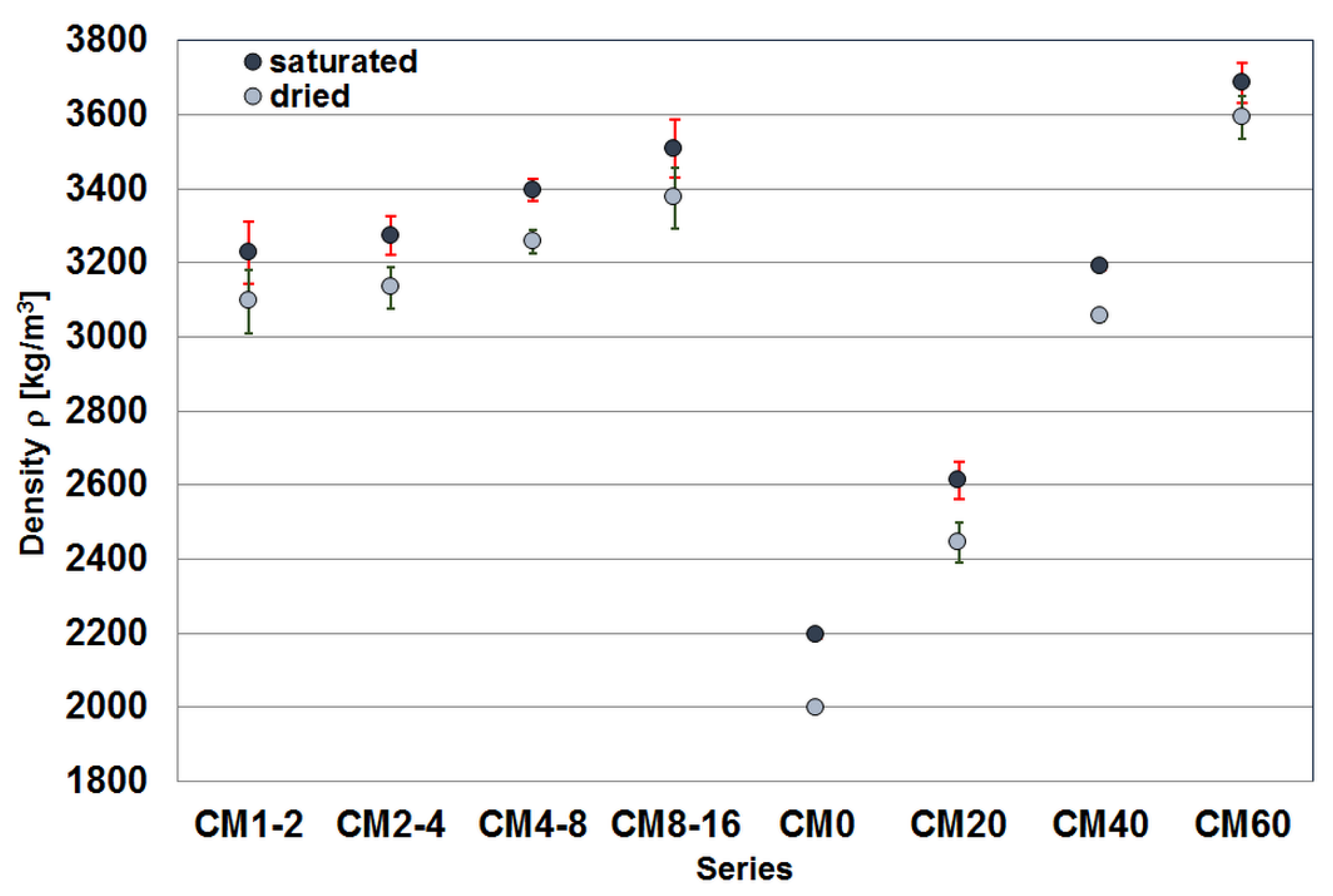
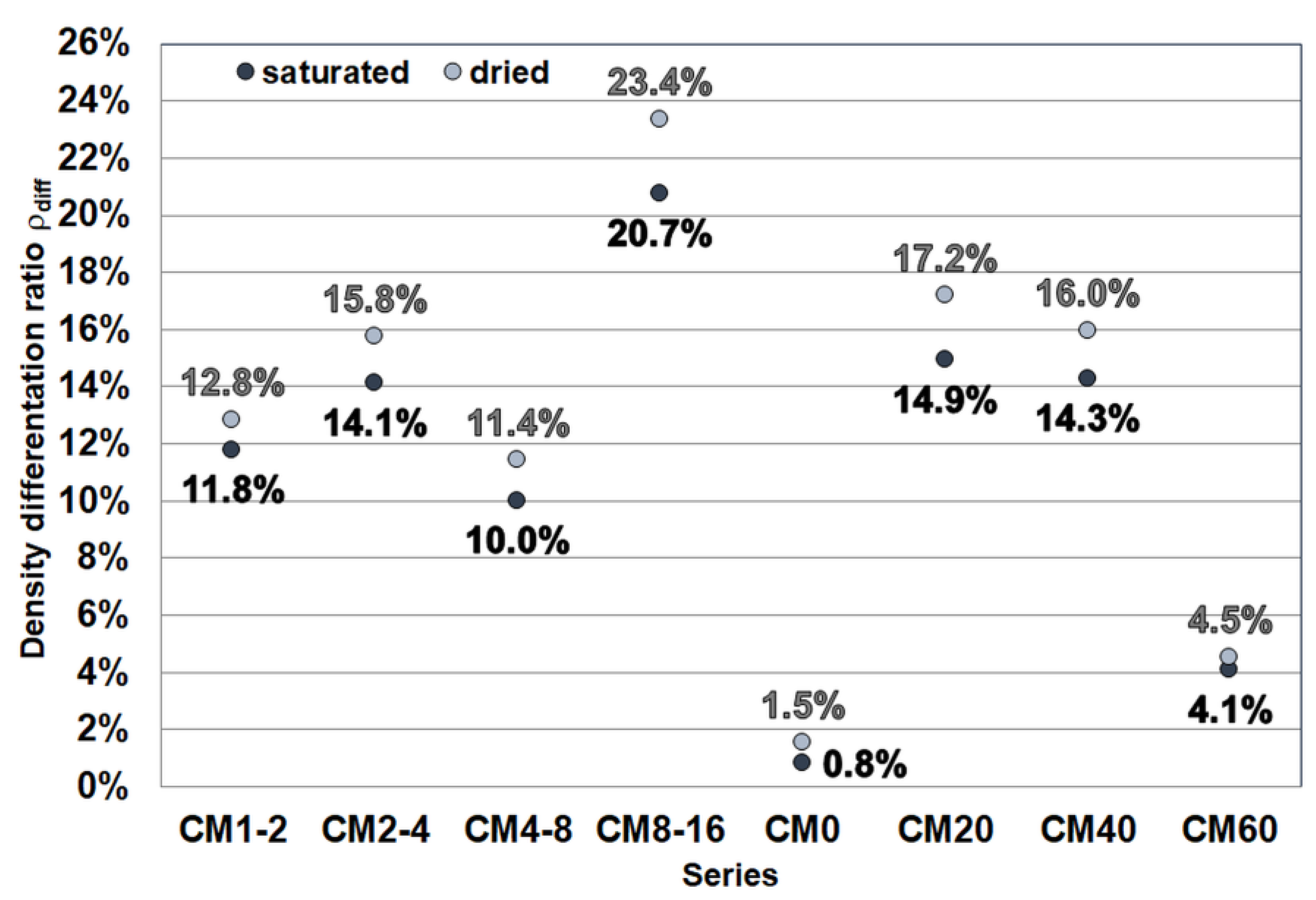

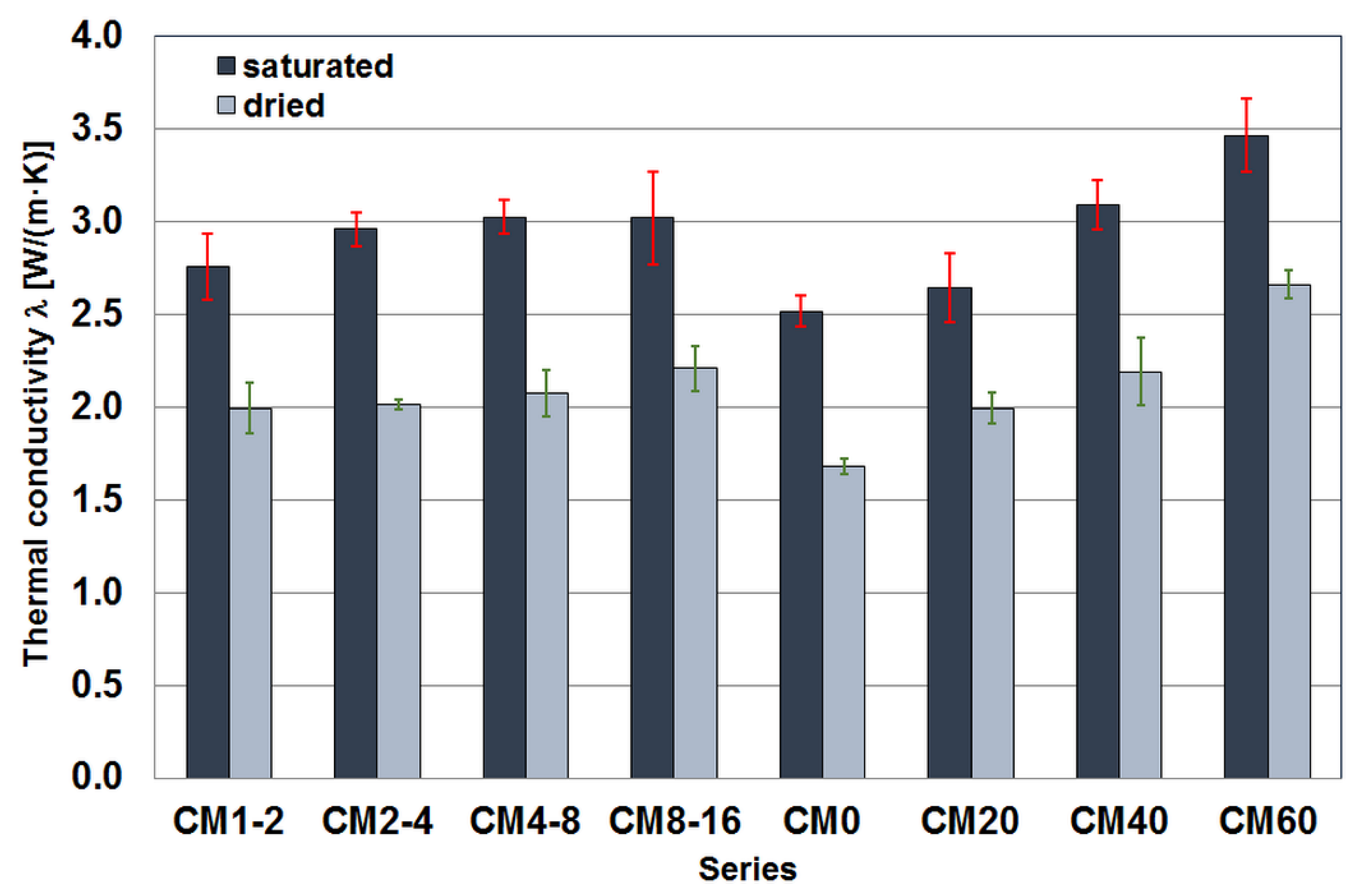
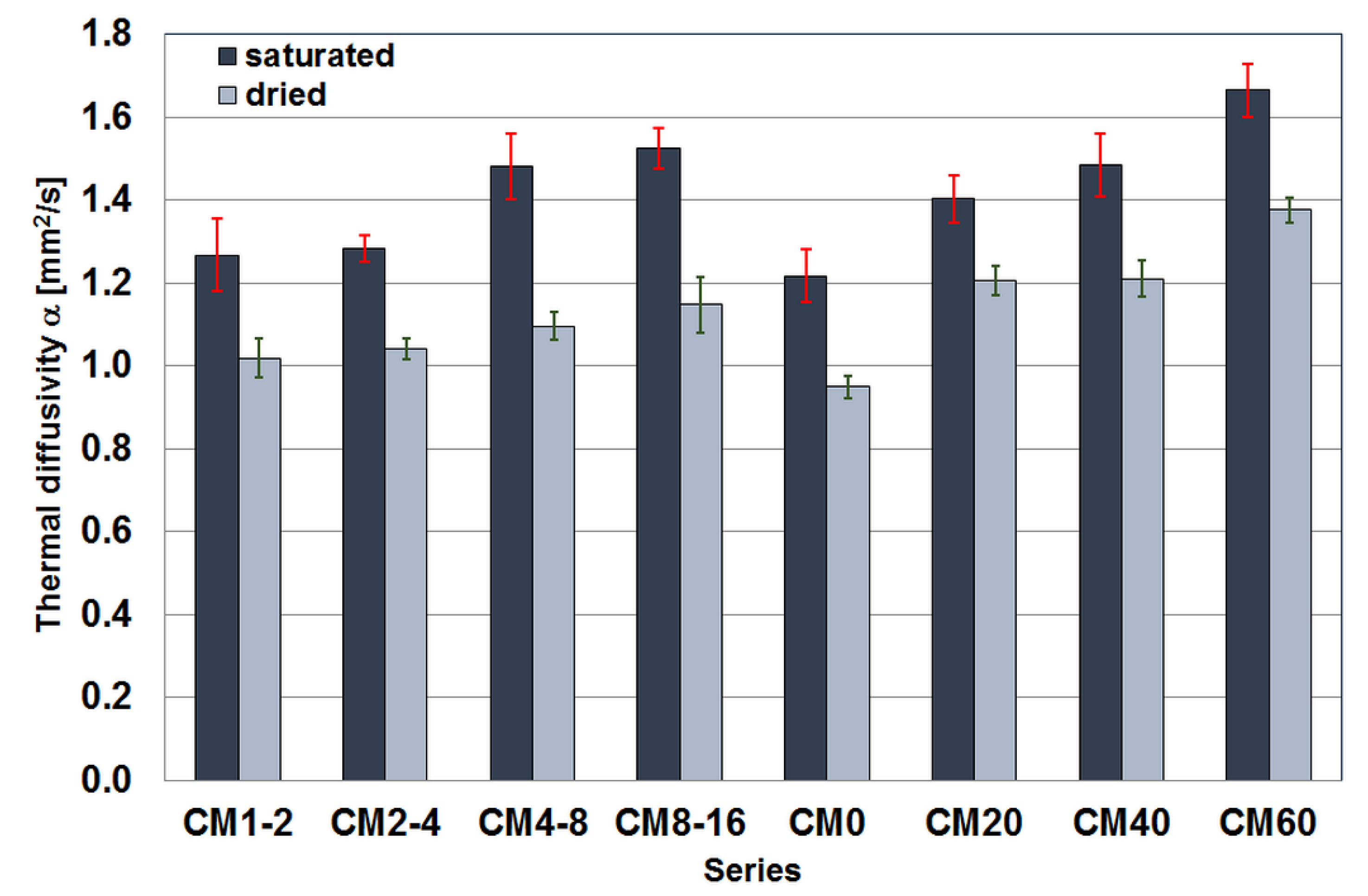
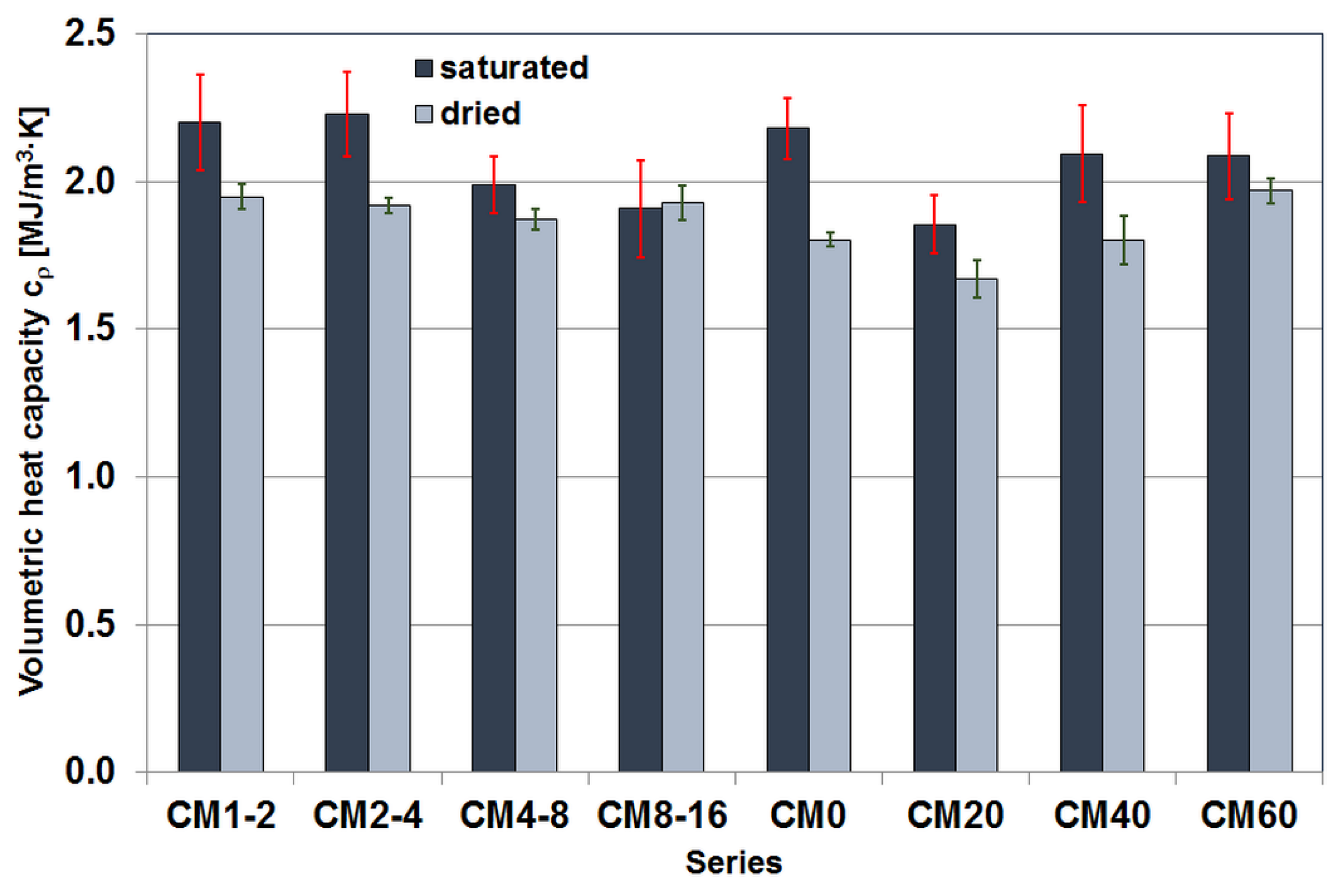

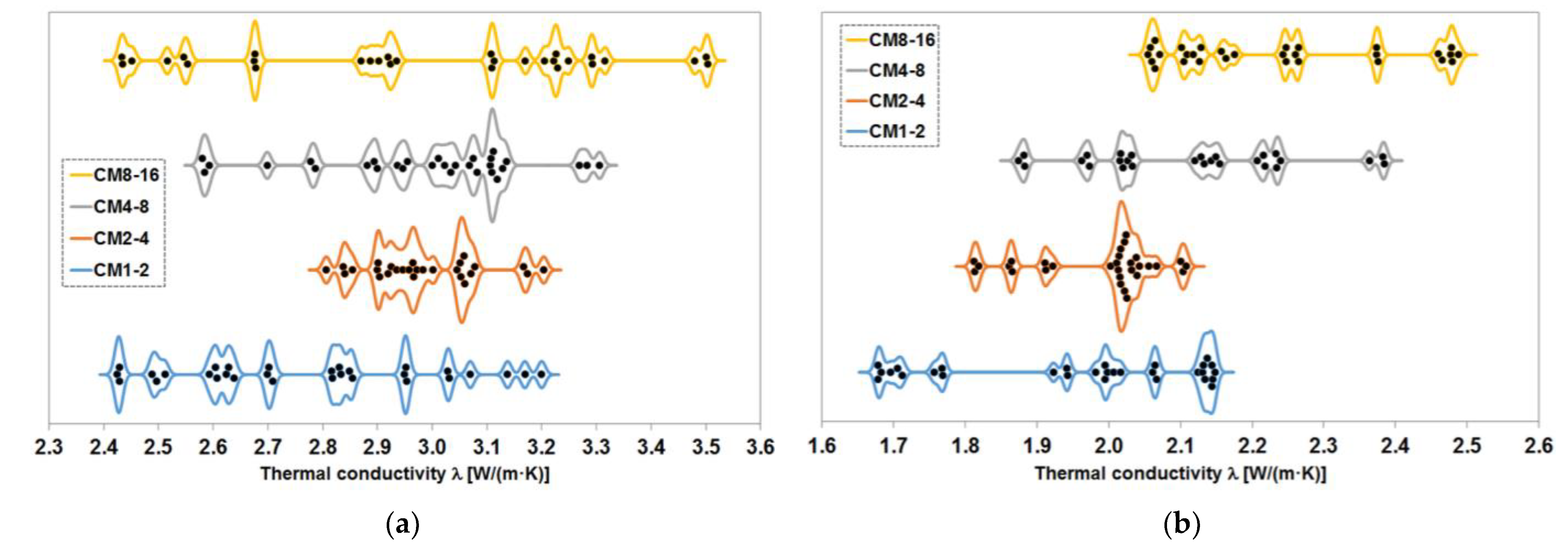



| Content/Parameter | CM 1-2 | CM 2-4 | CM 4-8 | CM 8-16 | CM0 | CM20 | CM40 | CM60 |
|---|---|---|---|---|---|---|---|---|
| Cement CEM II/B-V 32.5 | 360 | 360 | 360 | 360 | 600 | 480 | 360 | 240 |
| River sand 0–2 mm | 530 | 530 | 530 | 530 | 1325 | 1060 | 795 | 530 |
| Magnetite 1–2 mm | 2100 | -- | -- | -- | -- | 67 | 134 | 202 |
| Magnetite 2–4 mm | -- | 2100 | -- | -- | -- | 97 | 193 | 290 |
| Magnetite 4–8 mm | -- | -- | 2100 | -- | -- | 367 | 734 | 1101 |
| Magnetite 8–16 mm | -- | -- | -- | 2100 | -- | 309 | 618 | 927 |
| Water | 180 | 180 | 180 | 180 | 300 | 240 | 180 | 120 |
| Superplasticizer | -- | -- | -- | -- | -- | -- | -- | 0.96 |
| w/c | 0.5 | |||||||
| Magnetite (total) | 2100 | 2100 | 2100 | 2100 | 0 | 840 | 1680 | 2520 |
| % mass of the magnetite | 66.2% | 66.2% | 66.2% | 66.2% | 0.0% | 32.1% | 55.7% | 73.9% |
| % volume of the magnetite | 50% | 50% | 50% | 50% | 0% | 20% | 40% | 60% |
Disclaimer/Publisher’s Note: The statements, opinions and data contained in all publications are solely those of the individual author(s) and contributor(s) and not of MDPI and/or the editor(s). MDPI and/or the editor(s) disclaim responsibility for any injury to people or property resulting from any ideas, methods, instructions or products referred to in the content. |
© 2024 by the authors. Licensee MDPI, Basel, Switzerland. This article is an open access article distributed under the terms and conditions of the Creative Commons Attribution (CC BY) license (https://creativecommons.org/licenses/by/4.0/).
Share and Cite
Jaskulski, R.; Liszka, K.; Jóźwiak-Niedźwiedzka, D. Multifaceted Analysis of the Thermal Properties of Shielding Cement-Based Composites with Magnetite Aggregate. Materials 2024, 17, 2936. https://doi.org/10.3390/ma17122936
Jaskulski R, Liszka K, Jóźwiak-Niedźwiedzka D. Multifaceted Analysis of the Thermal Properties of Shielding Cement-Based Composites with Magnetite Aggregate. Materials. 2024; 17(12):2936. https://doi.org/10.3390/ma17122936
Chicago/Turabian StyleJaskulski, Roman, Krzysztof Liszka, and Daria Jóźwiak-Niedźwiedzka. 2024. "Multifaceted Analysis of the Thermal Properties of Shielding Cement-Based Composites with Magnetite Aggregate" Materials 17, no. 12: 2936. https://doi.org/10.3390/ma17122936






